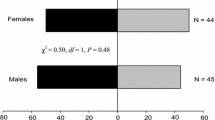Abstract
Adults of the sugarcane rootstalk borer weevil, Diaprepes abbreviatus, form aggregations on citrus trees, where they feed on new foliage. The relative roles of male and female weevils, frass, food, and combinations of these odor sources in aggregation formation were studied using a y-tube olfactometer. Female and male D. abbreviatus were attracted by food, males, females, and female or male frass. Females were most often attracted by damaged food (broken green beans), whereas males were similarly attracted to damaged food and either female frass, male frass, or heterosexual pairs. No enhancement of attraction by either sex was found when males and male frass were combined with damaged food.
Similar content being viewed by others
REFERENCES
ALCOCK, J., and GWYNNE, D. T. 1991. Evolution of insect mating systems: the impact of individual selectionist thinking, in W. J. Bailey and J. Ridsdill-Smith (eds.). pp. 10–41, Reproductive Behaviour of Insects. Chapman and Hall, London.
BAKER, T. C. 1983. Variations in male Oriental fruit moth courtship patterns due to male competition. Experientia 39:112–114.
BEAVERS, J. B., MCGOVERN, T. P., and ADLER, V. E. 1982. Diaprepes abbreviatus: Laboratory and field behavioral and attractancy studies. Environ. Entomol. 11:436–439.
BEN-YAKIR D., BAZAR, A., and CHEN, M. 1995. Attraction of Maladera matrida (Coleoptera: Scarabaeidae) to eugenol and other lures. J. Econ. Entomol. 88:415–420.
BUDENBERG, W. J., NDIEGE, I. O., KARAGO, F. W., and HANSSON, B. S. 1993. Behavioral and electrophysiological responses of the banana weevil, Cosmopolites sordidus, to host plant volatiles, J. Chem. Ecol. 19:267–277.
COUDRIET, D. L., and KISHABA, A. N. 1988. Bioassay procedure for an attractant of the pepper weevil (Coleoptera: Curculionidae). J. Econ. Entomol. 81:1499–1502.
CRUZ, C., and SEGRARRA, A. 1992. Potential for biological control of crop pests in the Caribbean. Fla. Entomol. 75:400–408.
DICKENS, J. C. 1989. Green leaf volatiles enhance aggregation pheromone of boll weevil, Anthonomus grandis. Entomol. Exp. Appl. 52:191–203.
FINCH, S. 1980. Chemical attraction of plant-feeding insect to plants. Appl. Biol. 5:67–144.
FLEMING, W. E. 1969. Attractants for the Japanese beetle. US Department of Agriculture Technical Bulletin 1399.
GREENFIELD, M. D. 1980. Moth sex pheromones: An evolutionary perspective. Fla. Entomol. 64:4–7.
HARARI, A. R., BEN-YAKIR, D., and ROSEN, D. 1994. Mechanism of aggregation behavior in Maladera matrida Argaman (Coleoptera: Scarabaeidae). J. Chem. Ecol. 20:361–371.
HARDEE, D. D., MITCHELL, E. G., and HUDDLESTON, E. B. 1966. Effects of age, nutrition, sex, and time of day on response of boll weevils to an attractant from cotton. Ann. Entomol. Soc. Am. 54:1024–1025.
HEATH R. R., LANDOLT P. J., LEPPLA, N. C., and DUEBEN, B. D. 1988. Identification of male-produced pheromone of Anticarsia gemmatalis (Hübner) (Lepidoptera: Noctuidae) attractive to conspecific males. J. Chem. Ecol. 14:1121–1130.
HEDIN, P. A., PAYNE, J. A., CARPENTER, T. L., and NEEL, W. 1979. Sex pheromones of the male and female pecan weevil, Curculio caryae: Behavioral and chemical studies. Environ. Entomol. 8:521–523.
JONES, I. F., and SCHROEDER, W. J. 1984. Capture of Diaprepes abbreviatus (Coleoptera: Curculionidae) in frass extract-baited traps in citrus. J. Econ. Entomol. 77:334–336.
LENCZEWSKI, B., and LANDOLT, P. J. 1991. Temporal partitioning of dual sexual attraction strategies in Trichoplusia ni (Lepidoptera: Noctuidae). Ann. Entomol. Soc. Am. 84:124–130.
MAYER M. S., and MCLAUGHLIN, J. R. 1990. Insect Pheromones and Sex Attractants. CRC Press, Boca Raton, Florida, 1096 pp.
PESCHKE, K. 1987. Male aggression, female mimicry and female choice in the rove beetle, Aleochara curtula (Coleoptera: Staphylinidae). Ethology 75:265–284.
PROKOPY, R. I., COOLEY, S. S., and PHELAN, P. L. 1995. Bioassay approaches to assessing behavioral responses of plum curculio adults (Coleoptera: Curculionidae) to host fruit odor. J. Chem. Ecol. 21:1073–1084.
REED, D. K., LEE, M. H., KIM, S. H., and KLEIN, M. G. 1991. Attraction of scarab beetle populations (Coleoptera: Scarabaeidae) to Japanese beetle lures in the Republic of Korea. Agric. Ecosyst. Environ. 36:163–174.
SCHROEDER, W. J. 1981. Attraction, mating, and oviposition behavior in field population of Diaprepes abbreviatus on citrus. Environ. Entomol. 10:898–900.
SCHROEDER, W. J., and BEAVERS, J. B. 1977. Citrus root weevils in Florida: Identification, biology, and control. Proc. Int. Soc. Citricult. 2:498–500.
SCHROEDER, W. J., and BEAVERS, J. B. 1985. Semiochemicals and Diaprepes abbreviatus (Coleoptera: Curculionidae) behavior: Implication for survey. Fla. Entomol. 68:399–402.
SIRJUSINGH C., KERMARREC, A., MAULEON, H., LAVIS, C., and ETIENNE, J. 1992. Biological control of weevils and white grubs on bananas and sugarcane in the Caribbean. Fla. Entomol. 75:548–562.
SOKAL, R. R., and ROHLF, F. J. 1969. Biometry. W. H. Freeman, San Francisco, 776 pp.
THORNHILL, R., and ALCOCK, J. 1983. The Evolution of Insect Mating Systems. Harvard University Press, Cambridge, Massachusetts, 547 pp.
TRIVERS, R. 1985. Deceit and self deception, pp. 395–420, in Social Evolution. The Benjamin/Cummings Publishing, Menlo Park, California.
TUMLINSON J. H., HARDEE, D. D., GUELDNER, R. C., THOMPSON, A. C., HEDIN, P. A., and MINYARD, J. P. 1969. Sex pheromones produced by male boll weevils: Isolation, identification, and synthesis. Science 166:1010–1012.
VISSER, J. H. 1986. Host odour perception in phytophagous insects. Annu. Rev. Entomol. 31:121–144.
WENDELKEN, P. W., and BARTH R. H., JR. 1985. On the significance of pseudofemale behavior in the neotropical cockroach genera Blaberus, Archimandria, and Byrostria. Psyche 92:493–504.
WILLIS, M. A., and BIRCH, M. C. 1982. Lek formation and female calling in a population of the arctiid moth Estigmene acrea. Science 218:168–170.
Rights and permissions
About this article
Cite this article
Harari, A.R., Landolt, P.J. Orientation of Sugarcane Rootstalk Borer Weevil, Diaprepes abbreviatus, to Weevil, Frass, and Food Odors. J Chem Ecol 23, 857–868 (1997). https://doi.org/10.1023/B:JOEC.0000006416.96240.aa
Issue Date:
DOI: https://doi.org/10.1023/B:JOEC.0000006416.96240.aa




